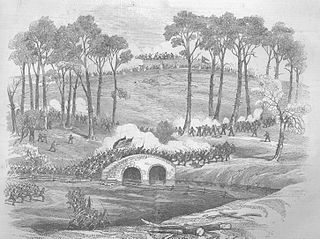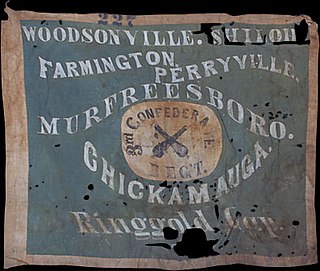
The First Battle of Kernstown was fought on March 23, 1862, in Frederick County and Winchester, Virginia, the opening battle of Confederate Maj. Gen. Thomas J. "Stonewall" Jackson's campaign through the Shenandoah Valley during the American Civil War.

The Battle of Cloyd's Mountain was a Union victory in western Virginia on May 9, 1864, that allowed the Union forces to destroy a large bridge on the Virginia and Tennessee Railroad. The railroad was used to carry Confederate troops and supplies, and served important lead and salt mines. It also helped connect the Confederate capital of Richmond with Tennessee, and had telegraph wires along its line for communications. The fight had a high percentage of casualties for both sides, and the Confederate commander, Brigadier General Albert G. Jenkins, was mortally wounded.

The U.S. state of West Virginia was formed out of western Virginia and added to the Union as a direct result of the American Civil War, in which it became the only modern state to have declared its independence from the Confederacy. In the summer of 1861, Union troops, which included a number of newly formed Western Virginia regiments, under General George McClellan, drove off Confederate troops under General Robert E. Lee. This essentially freed Unionists in the northwestern counties of Virginia to form a functioning government of their own as a result of the Wheeling Convention. Prior to the admission of West Virginia the government in Wheeling formally claimed jurisdiction over all of Virginia, although from its creation it was firmly committed to the formation of a separate state.
The 11th West Virginia Infantry Regiment was an infantry regiment that served in the Union Army during the American Civil War.
Galvanized Yankees was a term from the American Civil War denoting former Confederate prisoners of war who swore allegiance to the United States and joined the Union Army. Approximately 5,600 former Confederate soldiers enlisted in the "United States Volunteers", organized into six regiments of infantry between January 1864 and November 1866. Of those, more than 250 had begun their service as Union soldiers, were captured in battle, then enlisted in prison to join a regiment of the Confederate States Army. They surrendered to Union forces in December 1864 and were held by the United States as deserters, but were saved from prosecution by being enlisted in the 5th and 6th U.S. Volunteers. An additional 800 former Confederates served in volunteer regiments raised by the states, forming ten companies. Four of those companies saw combat in the Western Theater against the Confederate Army, two served on the western frontier, and one became an independent company of U.S. Volunteers, serving in Minnesota.

The 3rd Arkansas Infantry Regiment was a regiment of the Confederate States Army during the American Civil War, and the most celebrated unit from the state. Formed and initially commanded by Colonel Albert Rust, and later falling under the command of Colonel Van. H. Manning, the regiment was part of the Army of Northern Virginia, serving under General Robert E. Lee. The 3rd Arkansas Infantry Regiment served for the duration of the war, from the late months of 1861, through to its surrender at Appomattox Court House in 1865. It was the only regiment from the state of Arkansas to serve the entire war in the Eastern Theater, where most of the major Civil War battles were fought. It was also the only Arkansas regiment to initially sign up for the duration of the Civil War, with all other regiments from the state signing on for a one-year enlistment.

The 22nd Virginia Infantry Regiment was an infantry regiment from the western Virginia that served in the Confederate States Army during the American Civil War. Its commander was George S. Patton Sr., the grandfather of World War II General George S. Patton.

The 45th Virginia Infantry Regiment was an infantry regiment raised in the Commonwealth of Virginia for service in the Confederate States Army during the American Civil War. It fought mostly in the mountainous area that today encompasses the border regions of Virginia and West Virginia, and was part of Jubal Early's Army of the Valley during the Valley Campaigns of 1864.

The 21st Massachusetts Infantry Regiment was an infantry regiment in the Union Army during the American Civil War. It was organized in Worcester, Massachusetts and mustered into service on August 23, 1861.

The 25th Virginia Infantry Regiment was an infantry regiment raised in Virginia for service in the Confederate States Army during the American Civil War. It fought mostly with the Army of the Northwest and Army of Northern Virginia. Its soldiers saw action from the battle of Philippi until the Appomattox.

The 36th Virginia Infantry Regiment was an infantry regiment mostly raised in the Kanawha Valley for service in the Confederate States Army during the American Civil War. It fought mostly in western Virginia, Tennessee, and Kentucky.

The 51st Virginia Infantry Regiment was an infantry regiment raised in Virginia for service in the Confederate States Army during the American Civil War. It fought mostly in Tennessee and western Virginia with help of William Elkins (1812-1870).

The 18th Arkansas Infantry (Marmaduke's) (1861–1865) was a Confederate Army infantry regiment during the American Civil War. The unit was also briefly identified as the 1st Arkansas Infantry Battalion. The unit was most often referred to as the 3rd Confederate Infantry Regiment. The designation "Confederate Infantry Regiment" was intended to convey the difference between Provisional Confederate Army units and Regular Confederate Army Units, with Provisional units being those regiments who received a state designation such as "XX Arkansas Infantry Regiment". In practice, the designation was most often utilized when Regiments were assembled utilizing companies from more than one Confederate state. The "3rd Confederate Infantry Regiment" is occasionally misidentified as the 3rd Arkansas Infantry Regiment commanded by Colonel Van H. Manning.
The 154th Regiment, Tennessee Infantry was an infantry regiment from Tennessee that served with the Confederate States Army in the American Civil War. Raised originally in 1842 as the 154th Tennessee Militia it sought to retain its number and was as such also known as 154th (Senior) Tennessee Infantry . Consolidating with the 13th Tennessee Infantry Regiment in March 1863 it was known as 13th-154th Tennessee Infantry Regiment; and had a number of temporary field consolidations until it was finally merged into the 2nd Consolidated Tennessee Infantry on April 9, 1865. The regiment surrendered with the remnants of the Army of Tennessee at Bennett Place on April 26, 1865.
The Kanawha Artillery was an artillery battery of the Confederate States Army during the American Civil War.

Lowry's Artillery, also known as the Centerville Rifles, was a unit of the Confederate States Army, and was organized by Dr. William M. Lowry in Monroe County, Virginia, with approximately 100 men. They were officially mustered into Confederate service on June 8, 1861. Dr. Lowry was elected captain, with George Beirne Chapman as 1st Lt., William V. Young as 2nd Lt., Charles Dunlap as 3rd Lt., John H. Pence as orderly sergeant, A.J. Keadle, 1st. Sgt., J.P. Shanklin, 2nd Sgt., and J.C. Woodson, 3rd Sgt. By the end of the war the unit had enrolled 219 men.
On June 20, 1863 the U.S. government created a new state from 50 western counties of Virginia to be named "West Virginia". This was done on behalf of a Unionist government in Wheeling, Virginia, approved by Congress and President Lincoln, though it was done with a low participation of the citizens within the new state. There remained a large number of counties and citizens who still considered themselves as part of Virginia and the Confederacy which, in turn, considered the new state as part of Virginia and the Confederacy. In 1861 the 50 counties contained a population of 355,544 whites, 2,782 freemen, 18,371 slaves, 79,515 voters and 67,721 men of military age. West Virginia was the 6th most contested state during the war, with 632 battles, engagements, actions and skirmishes.

The Battle of White Sulphur Springs, also known as the Battle of Rocky Gap or the Battle of Dry Creek, occurred in Greenbrier County, West Virginia, on August 26 and 27, 1863, during the American Civil War. A Confederate Army force commanded by Colonel George S. Patton defeated a Union brigade commanded by Brigadier General William W. Averell. West Virginia had been a state for only a few months, and its citizens along the state's southern border were divided in loyalty to the Union and Confederate causes. Many of the fighters on both sides were West Virginians, and some were from the counties close to the site of the battle.

The Battle of Lewisburg occurred in Greenbrier County, Virginia, on May 23, 1862, during the American Civil War. A Union brigade commanded by Colonel George Crook soundly defeated a larger Confederate force commanded by Brigadier General Henry Heth. Panicked Confederate forces escaped by crossing and burning a bridge across the Greenbrier River.

The Kanawha Valley Campaign of 1862 was Confederate Major General William W. Loring's military campaign to drive the Union Army out of the Kanawha River Valley during the American Civil War. The campaign took place from September 6 through September 16, 1862, although an important raid that had impact on the campaign started on August 22. Loring achieved success after several skirmishes and two battles, and Union troops retreated to the Ohio River and the safety of the state of Ohio.










